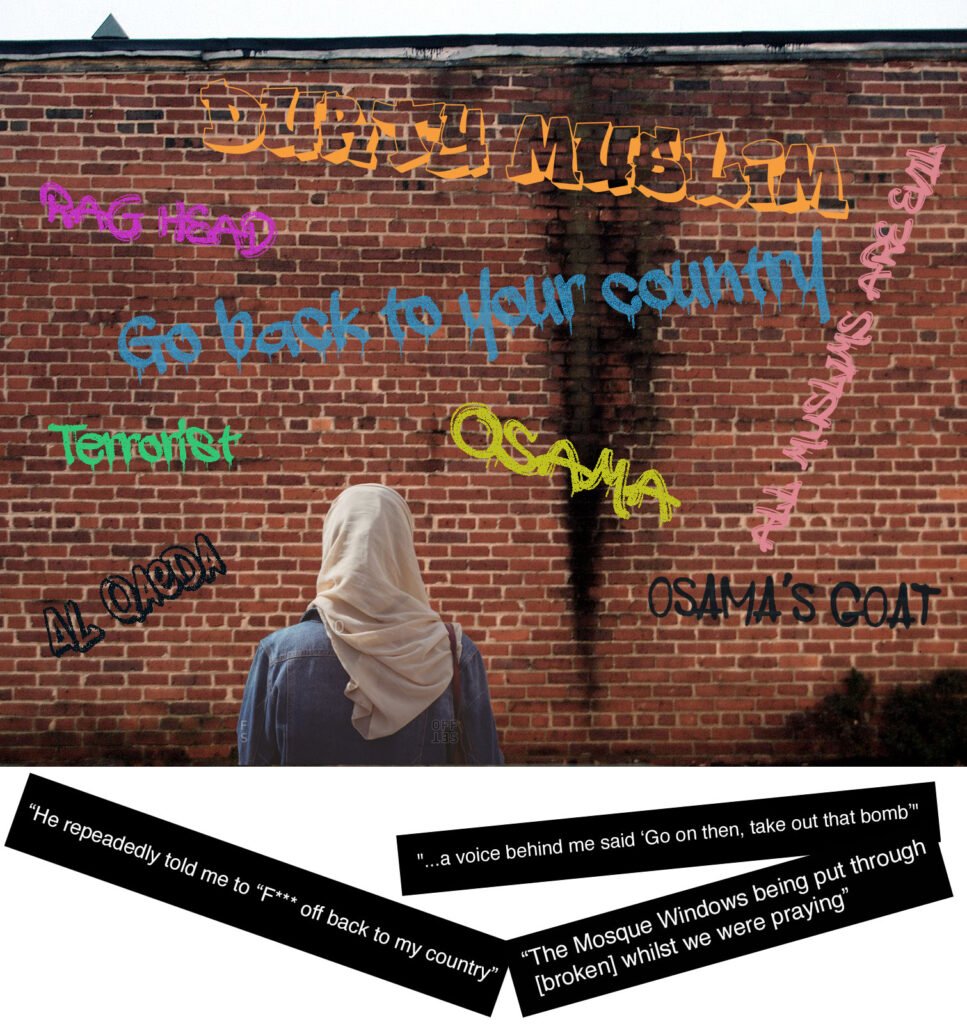
The impact of September 11th, 2001
Islamophobia is defined as “a fear or dislike of Muslims” (Sheridan 317). Coined in 1991, the term gained popularity after the 1997 publication of a report by an English-based racial equality think tank, Runnymede Trust. Since the September 11th, 2001 terrorist attack, when Osama Bin Laden and Al-Qaeda orchestrated the hijacking and suicide mission of commercial airplanes, Islamophobia has dramatically increased. Muslim hate crimes in the US rose 1700% in 2001, a direct impact of 9/11 (Tindongan 2011). The issue is not unique to the United States. In a study conducted with British Muslims, 82.6% reported experiencing an increase in discrimination post-9/11 (Sheridan 2006). The European Monitoring Centre on Racism and Xenophobia’s identified an increase in Islamophobia in all 15 member states of the European Union (Sheridan 2006).
The most common experiences of harassment were through offensive humor, public staring, name-calling, and the spread of hurtful stereotypes. Common anti-Muslim epithets include being called a “Terrorist,” “dirty Muslim,” “camel jockey,” and “rag head” (Peek 2011). In a 2006 study of Muslim Americans, over 1/6th of participants reported such discrimination led to experiences of violence or other life-threatening situations (Sheridan 2006).
The Trump Administration’s Impact
Former President Donald Trump further contributed to the rise of Islamophobia. In his 2016 campaign, Trump called for “a total and complete shutdown of Muslims entering the United States” following the San Bernardino terrorist attack, a shooting carried out by a Muslim pair. In the days after his announcement, anti-Muslim hate crime rose 87.5% (Levin 2016).
Divisive and derogatory comments continually made throughout his Presidency set an example to the American people that discrimination is acceptable. In 2017, Trump signed his Executive Order, “Protecting the Nation from Foreign Terrorist Entry into the United States,” conveyed as the “Muslim ban” by the media (Ng and Stamper 2018). This order banned immigration from seven Muslim nations, even though there had never been a terrorist suspected of crimes against the United States from any of these nations. Further instances include Trump claiming a New Jersey Muslim community cheered on 9/11 and suggesting the shutdown of mosques across the United States due to the hatred emerging from them (Ng and Stamper 2018).
After just one year of Trump’s presidency, the immigration of Muslim refugees decreased 90% and violence against Muslims rose 15%. Additionally, between the beginning of his campaign and 2019, Muslim hate groups in America have tripled (Everett Marko 2019).
Influence on Muslim Communities
The recent dramatic rise in Islamophobia has adversely affected Muslim people. Muslims expressed feeling abandoned by the US, stemming from public policy changes that began in response to 9/11. Among those who were citizens, many felt they weren’t treated as citizens. Those aspiring for citizenship noted a delay in the citizenship process due to their religious identity (Awaldi 2014). Muslims also shared they now experience lengthy and unnecessary airport security checks. (Peek 2011).
The rise in Islamophobia has presented Muslims with difficulties in the employment process. One interviewee, 30-year-old Muslim, Hussein, found discrimination in the job search so prevalent that he Americanized his name. With the new name, Hussein obtained several interviews and quickly landed a job (Awaldi 2014).
We are living in a crisis of Islamophobia stemming from escalating historical events over the past two decades. Combatting this crisis is a necessity; how to do so will be the challenge.
References
Awadi, Ali G. 2014. “How the Events of 9/11 Shaped the Lives of Arab American Muslims in American Society.” Ph.D. dissertation, Walden University, United States — Minnesota (https://www.proquest.com/dissertations-theses/how-events-9-11-shaped-lives-arab-american/docview/1524699464/se-2?accountid=11264).
Everett Marko, David. 2019. “Nevertheless, they Persist: American and European Muslim Immigrants in the Era of Trump.” Journal of Muslim Minority Affairs 39(2):246-258 (https://www.proquest.com/scholarly-journals/nevertheless-they-persist-american-european/docview/2249649332/se-2?accountid=11264). doi: http://dx.doi.org/10.1080/13602004.2019.1620006.
Levin, Brian. 2016. Hate Crime in the United States. San Bernardino, California.
Ng, Eddy S., and Christina L. Stamper. 2018. “A Trump Presidency and the Prospect for Equality and Diversity.” Equality, Diversity and Inclusion: An International Journal 37(1):2-13 (https://www.proquest.com/scholarly-journals/trump-presidency-prospect-equality-diversity/docview/2014313595/se-2?accountid=11264). doi: http://dx.doi.org/10.1108/EDI-12-2017-0282.
Peek, Lori. 2011. Behind the Backlash; Muslim Americans After 9/11.Temple University Press (http://www.jstor.org/stable/j.ctvrdf3dw). doi: 10.2307/j.ctvrdf3dw.
Sheridan, Lorraine P. 2006. “Islamophobia Pre– and Post–September 11th, 2001.” J Interpers Violence 21(3):317-336 (https://doi.org/10.1177/0886260505282885). doi: 10.1177/0886260505282885.
Tindongan, Cynthia W. 2011. “Negotiating Muslim Youth Identity in a Post-9/11 World.” The High School Journal 95(1):72-87 (http://www.jstor.org/stable/41236889).